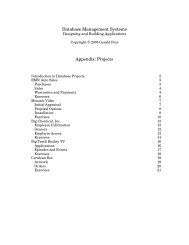Revision History - Jerry Post
Revision History - Jerry Post
Revision History - Jerry Post
Create successful ePaper yourself
Turn your PDF publications into a flip-book with our unique Google optimized e-Paper software.
$25 billion constitutes the bulk of the $26 billion debt (mostly public bonds) of TVA, but the<br />
nuclear plants generated only 14 percent of TVA’s total power supply in 1994. In 2004, TVA<br />
announced plans to reopen Browns Ferry 1 at an anticipated cost of $1.8 billion [Hampton<br />
and Ichniowski 2004]. If it opens on time in 2007, it will be the first new U.S. nuclear plant<br />
since 1996.<br />
TVA in the 1990s<br />
TVA is under federal mandate to fund its electricity production from ongoing operations.<br />
By its internal accounting methods, TVA is meeting this mandate; however, $14 billion<br />
of the nuclear construction debt is not being financed from current operations. In 1995,<br />
TVA had a total debt of $26 billion, with financing costs of $1.9 billion a year (35 percent of<br />
its power revenues). TVA faces a Congressionally imposed debt ceiling of $30 billion, and<br />
TVA expects to increase its debt to about $28 billion by 1997—in part to cover final production<br />
costs at Watts Bar, in part to cover interest payments on its debt. As a federal agency,<br />
TVA cannot sell stock (like most traditional utilities), so all funds must be raised from bond<br />
sales. Although these sales are not guaranteed by the federal government, some investors<br />
believe that the federal government will not allow TVA to default on the bonds. Consequently,<br />
TVA has a slight advantage over potential competitors in terms of interest rates.<br />
Similarly, TVA does not pay federal income taxes.<br />
TVA also anticipates the need for substantial expenditures to improve existing hydroelectric<br />
and coal-fired plants. Additional expenses will also be incurred in bringing all of<br />
the coal-fired plants into compliance with the Clean Air Act. Based on preliminary estimates,<br />
TVA anticipates spending between $1.1 and $1.6 billion between 1995 and 2015 (in<br />
constant 1994 dollars). By 2003, TVA was still reporting total debt of about $25 billion [annual<br />
report].<br />
In public statements, TVA repeatedly emphasized that they had not raised electricity<br />
rates in nine years, and they are trying to hold them stable for at least 10 years. Nonetheless,<br />
TVA is not the lowest-cost producer in the area. However, for the immediate future,<br />
other firms are prohibited from selling electricity to TVA’s customers.<br />
As part of the Energy Policy Act of 1992, TVA is conducting an integrated resource<br />
planning (IRP) process—largely to determine future goals, changes in production and operations,<br />
and the least-cost means of providing power. TVA is conducting the plan with several<br />
interdisciplinary teams:<br />
• Issues and Values Translation Team<br />
• Evaluation Criteria Team<br />
• Load Forecasting Team<br />
• Existing Capabilities Team<br />
• Supply-Side Options Team<br />
• Customer Service Options Team<br />
• Environment Team<br />
• Rankings Team<br />
• Strategy Development Team<br />
• Uncertainties Team<br />
• Integration Team<br />
Each of these teams is responsible for identifying problems, making forecasts, and<br />
presenting and evaluating alternatives. Many of the teams use statistical and computer<br />
10







